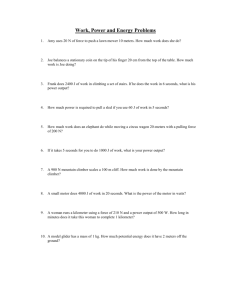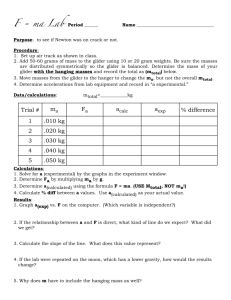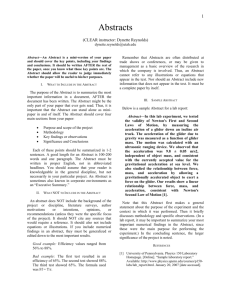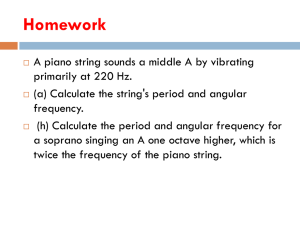Experiment 6: Work and Energy
advertisement
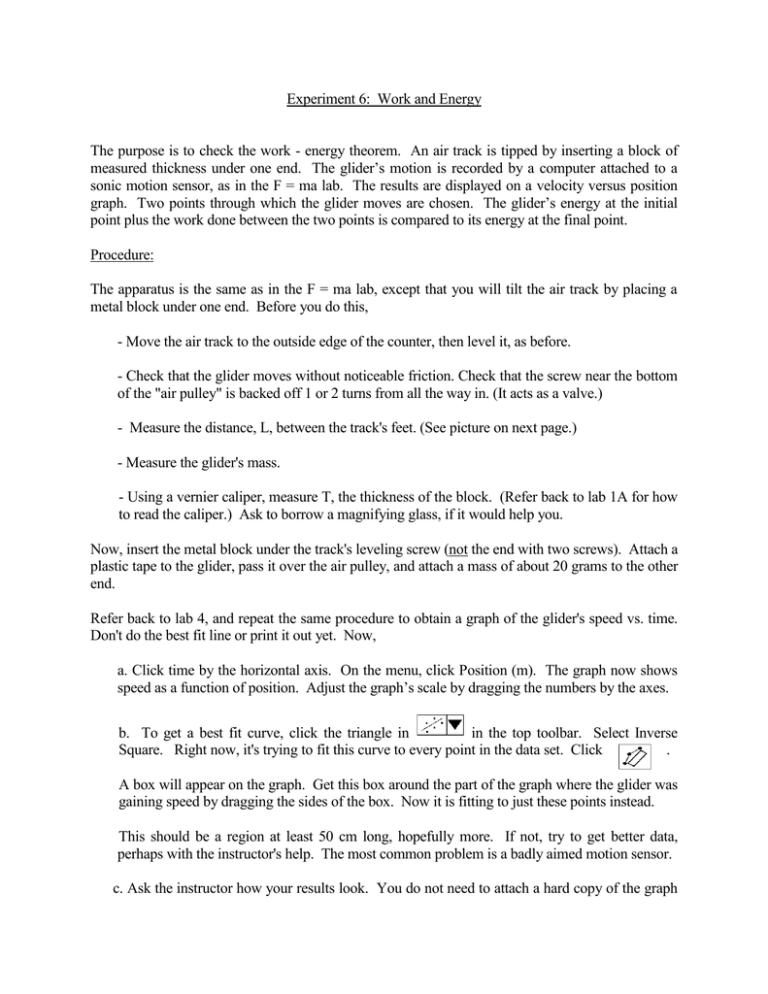
Experiment 6: Work and Energy The purpose is to check the work - energy theorem. An air track is tipped by inserting a block of measured thickness under one end. The glider’s motion is recorded by a computer attached to a sonic motion sensor, as in the F = ma lab. The results are displayed on a velocity versus position graph. Two points through which the glider moves are chosen. The glider’s energy at the initial point plus the work done between the two points is compared to its energy at the final point. Procedure: The apparatus is the same as in the F = ma lab, except that you will tilt the air track by placing a metal block under one end. Before you do this, - Move the air track to the outside edge of the counter, then level it, as before. - Check that the glider moves without noticeable friction. Check that the screw near the bottom of the "air pulley" is backed off 1 or 2 turns from all the way in. (It acts as a valve.) - Measure the distance, L, between the track's feet. (See picture on next page.) - Measure the glider's mass. - Using a vernier caliper, measure T, the thickness of the block. (Refer back to lab 1A for how to read the caliper.) Ask to borrow a magnifying glass, if it would help you. Now, insert the metal block under the track's leveling screw (not the end with two screws). Attach a plastic tape to the glider, pass it over the air pulley, and attach a mass of about 20 grams to the other end. Refer back to lab 4, and repeat the same procedure to obtain a graph of the glider's speed vs. time. Don't do the best fit line or print it out yet. Now, a. Click time by the horizontal axis. On the menu, click Position (m). The graph now shows speed as a function of position. Adjust the graph’s scale by dragging the numbers by the axes. b. To get a best fit curve, click the triangle in in the top toolbar. Select Inverse Square. Right now, it's trying to fit this curve to every point in the data set. Click . A box will appear on the graph. Get this box around the part of the graph where the glider was gaining speed by dragging the sides of the box. Now it is fitting to just these points instead. This should be a region at least 50 cm long, hopefully more. If not, try to get better data, perhaps with the instructor's help. The most common problem is a badly aimed motion sensor. c. Ask the instructor how your results look. You do not need to attach a hard copy of the graph to your report if the instructor looks at it on the computer screen. Do not delete the file until you are completely done and the instructor has approved your paper. Click on . Drag the crosshairs to a point on the best fit curve near the start and read its coordinates, xi and vi . Drag it to a point near the other end to read xf and vf. Again, the x values should be at least 50 cm apart, hopefully more. ANALYSIS OF DATA 1. Picture an x axis going along the air track. Determine the distance, s, between points xi and xf. 2. Find the vertical distance, Δh, which the glider moves between points i and f. (This is not just the thickness of the block.) Notice that the two highlighted triangles are similar triangles, and therefore have the same ratio between their sides: Δh/s = T/L. Knowing s, T, and L from your measurements, find Δh. We want to verify the work-energy theorem by determining the glider's energy at point i, its energy at point f, and the work done in between: 3. Calculate the glider’s KE + PE at point i: You can think of point i as being at the level you will measure height from, which makes hi zero. 4. Find the work from work's definition. The force on the glider approximately equals the weight of the counterweight. The distance which this force acts through is s. 5. Add. Calculate 5% of this for its uncertainty. (One source of error is that the force on the glider is actually a little less than the counterweight, due to the system's acceleration.) 6. Calculate the glider’s KE + PE at point f. Remember the glider is now Δh higher than it was at point i. + 5% again. 7. In your discussion, you don’t have to explain the air track or motion sensor since you already did that for lab 4. For its conclusion, state whether initial energy plus work agrees with the final energy. Please remove any tape you put on the weight or glider. Also, shut down the computer and put it back in the cart, with its charger plugged in. PHY 121 Experiment 6: Work and Energy L = _____________ T = _____________ mG = ______________ mCW = ______________ Initially: xi = ______________ vi = ______________ Finally: xf = ______________ vf = ______________ s = ____________ Compute Δh: Compute initial KE + PE: Compute work: (KE + PE)i + W = _______________ + _______________ Compute final KE + PE:

